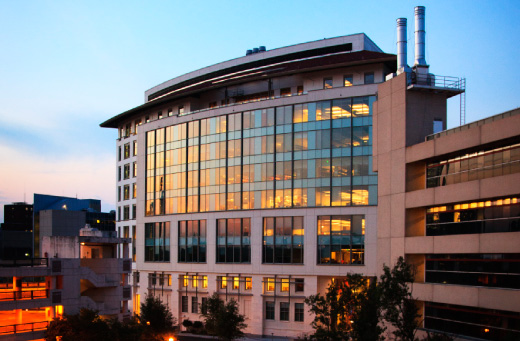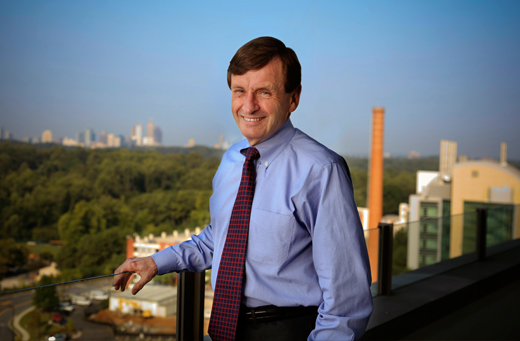1518 Clifton Road
A school rises to become a global destination for public health
By Pam Achmutey
Thirty-five years ago, few may have noticed the white, blue-shuttered house at 1518 Clifton Road. Inside the modest structure was a small and dedicated group of experts concerned about the health of communities. Like proud parents, the founders of Emory’s public health program knew it was destined to succeed.
Today, the Rollins School of Public Health resides in two multi-level buildings in which the signs of success are apparent. “Emory strives to be a destination university, and the school’s newly expanded complex is designed to be a destination for public health research and education,” says President James Wagner.
Wright Caughman, interim executive vice president for health affairs, calls the school “an international force in serving the health needs of the planet.”
For the past two years, construction of a second public health building created its share of inconvenience and interest. Amid the scaffolding, dust, and noise, applications and acceptances to the school rose by more than 10% after prospective students toured the school last spring.
“The building portrays optimism for the future,” says Dean James Curran. “It shows that we’re committed to public health and research at Emory.”
Likewise, the building helped Paige Tolbert recruit seven new faculty members in environmental health during the past 18 months. She began touting the school’s expansion to prospective faculty after becoming department chair in 2007, a year before construction began. The promise of new laboratory space aided her recruitment efforts and helped new and established faculty in their bids for new research funding. By fall 2011, the department expects to enroll its first PhD students. “This takes us to a new place,” says Tolbert of her department’s growth.
Indeed, prospects are bright throughout the RSPH as it marks 35 years as a program, 20 years as a school, and 15 years of leadership under Curran. All of these milestones coincide with the opening of the Claudia Nance Rollins Building and the renovation of the Grace Crum Rollins Building. The addition of the second building more than doubles the physical size of the school to create a complex that firmly anchors Emory’s health sciences corridor along Clifton Road and raises Rollins’ visibility as one of the top schools in the field.
“What emanates from the school is as important as what comes into the school,” says Michael Johns, university chancellor and former executive vice president for health affairs. “We want to be a place that attracts the very best students, staff, and faculty. We produce new knowledge. We educate students to become public health workers and leaders. It’s the coming and going that makes this place special.”
When Johns arrived at Emory in 1996, Curran had become dean of Rollins, a relatively new school, the year before. Despite the school’s young age, it had already attracted a critical mass of teachers, researchers, and students. “The whole thing was primed to go,” Johns recalls. “The stars were aligned.”

Claudia Nance Rollins Building
Laying the foundation
When Johns and Curran joined Emory, the RSPH had been a work in progress for two decades. The foundation was laid in the form of the Masters of Community Health (MCH) program that admitted its first class of 16 students in June 1975. The brainchild of Emory medical faculty members Bill Marine and Tom Sellers and CDC director David Sencer, the MCH program targeted both early and mid-career health professionals and relied on the expertise of partners from the CDC, the Atlanta Regional Commission, the Georgia Department of Human Resources, Georgia State University, and the Emory School of Business.
“From the beginning, they wanted the program to be a center of excellence for public health training and capitalize on the location of Emory, the CDC, and other partners in Atlanta,” says 1977 graduate Virginia Bales Harris, who served with the CDC for 35 years.
The same year that the MCH program admitted its first students, administrators moved their offices from Grady Memorial Hospital to the small house at 1518 Clifton Road, now the permanent address for the school. By the early 1980s, the program was accredited and had expanded into two additional houses and a trailer nearby. The program was growing but operating at a deficit. Then, in 1982, CDC veteran Eugene Gangarosa, who also founded the public health program at American University of Beirut, became director.
From the start, Gangarosa envisioned a public health school with its own building. He used Emory’s proximity to the CDC to attract more students, increasing enrollment from 16 to approximately 40 part-time students during his first year. He asked his CDC colleagues to teach as adjunct faculty, thus raising the number of courses from 12 to 55. The number of full- and part-time program faculty grew as well, providing expertise to establish tracks in international health, environmental and occupational health, epidemiology, and health education.
In 1983, Emory changed the program’s name from Masters of Community Health to Masters of Public Health to convey a larger worldview. This mindset reflected Gangarosa’s own experiences working overseas and for which he would later provide scholarship support for students to work in other countries. “You can’t teach public health entirely in the classroom,” Gangarosa observed during the school’s 10th anniversary in 2000.
Momentum to create a school began to build in 1987, when the School of Medicine appointed Ray Greenberg to oversee its new Department of Epidemiology and Biostatistics. A year later, the department and the MPH program moved to the new American Cancer Society (ACS) Building on Clifton Road. The move strengthened an already close working relationship among colleagues and propelled the program to become a division in 1989. In September 1990, Emory’s Board of Trustees granted the division school status and appointed 35-year-old Greenberg as dean. It was the first new school of public health to be established at a private academic institution in 50 years and the first new school at Emory since 1919, when the business school was born.
School on the rise
Greenberg had his work cut out as dean. “It was a double challenge,” says Greenberg, now president of the Medical University of South Carolina (MUSC) in Charleston. “Not only was the school getting established, but faculty were also getting established. Many of them were at the beginning their careers. If you were looking for an established place to start your career, this was not the place for you. If you were an individual looking for a place where you could make a significant impact, that was the kind of person who was coming to us.”
Many of those faculty remain with the school today: Gangarosa, John Boring, Richard Levinson, Kathleen Miner, Nancy Thompson, Michael Kutner, and Roger Rochat, among others.
“A lot of people have made the school their life’s work,” says Kathryn Graves, who joined the MPH division in 1989 and now serves as associate dean for development and external relations. “They have shared their talents and wisdom from the beginning.”
Graves was among those who helped Greenberg face another daunting task: raising funds for the new school. “Fortunately, we became very blessed very quickly,” he says.
Under Greenberg’s leadership, the number of faculty tripled, and student enrollment doubled. The Kellogg and Humphrey fellowship programs were established, raising the school’s stature nationally and internationally. The school’s research portfolio emerged second behind the School of Medicine. Partnerships flourished within the university and with the CDC, ACS, the Arthritis Foundation, the Carter Center, CARE, the Task Force for Child Survival and Development (today’s Task Force for Global Health), and the state of Georgia. The school quickly outgrew its rented space in the ACS building
Among the school’s blessings was Atlanta businessman and Emory trustee O. Wayne Rollins. When the topic of a school of public health building was raised during a fund-raising meeting, Rollins expressed his support. He and his family were long-time supporters of Emory, with major gifts to Candler School of Theology and the O. Wayne Rollins Research Center in the School of Medicine. After the philanthropist died unexpectedly in 1991, his wife Grace and their sons Randall and Gary provided a major gift to construct a 10-story building to house the School of Public Health. Prior to the opening of the Grace Crum Rollins Building in late 1994, Emory named the school for the Rollins family to honor their generosity.
When Greenberg left Emory for MUSC in 1995, Emory chose James Curran as the school’s next leader. “The fact that he is now the second longest-serving public health dean in the country has been important to Rollins’ success,” says Greenberg.
The next tier
Curran has followed two paths in public health. During his 24 years with the CDC, he spent 15 of those years leading the nation’s efforts against the HIV/AIDS epidemic. While at the CDC, Curran had a front row seat to watch the growth of the RSPH.
“The founders of the school had a vision of global health while recognizing that most of the faculty and graduates would be working on health problems germane to the state of Georgia and the United States. Having that dual focus was important,” says Curran.
“When I came to the school, I saw a place that, although it was new, was grounded in excellence in teaching and research,” he adds. “The school was part of an excellent university in a city renowned worldwide for public health. And we were the first U.S. school of public health to be named after a supporter. I could see nothing but potential.”
Curran has not been disappointed. In 1995, research funding totaled approximately $13 million. Today it stands at more than $64 million, supporting local, national, and global efforts in cancer epidemiology, nutrition, environmental health, HIV/AIDS education and prevention, addictive behaviors, youth violence, antibiotic resistance, diabetes and obesity, health policy, and health resource allocation.
More than 20 faculty members hold endowed chairs, including diabetes researcher K.M. Venkat Narayan (the Ruth and O.C. Hubert Professor of Global Health) and antibiotic resistance expert Keith Klugman (the William F. Foege Chair in Global Health). Both researchers are based in the Hubert Department of Global Health, the first solely named department on the Emory campus and the first such named department in a U.S. school of public health. Last year, Emory HIV specialist Carlos del Rio joined the department as Hubert Professor and chair. The Hubert Foundation, which funded all three professorships, has provided more than $13 million to the RSPH, honoring the wishes of the late O.C. Hubert, a Cobb County landowner, to improve health.
The school has evolved in other directions. Curran co-directs the NIH-funded Center for AIDS Research, uniting the resources and expertise of more than 300 Emory scientists and clinicians to prevent and treat the disease. The CDC-funded Emory Prevention Research Center works with community partners in rural Georgia to reduce cancer rates. Health policy professor Benjamin Druss holds the Rosalynn Carter Chair of Mental Health, the first joint appointment between the RSPH and the Carter Center.
Following 9/11, the Rollins family provided funding to establish the Center for Public Health Preparedness and Research, directed by Rollins Professor Ruth Berkelman. Christine Moe, the Eugene J. Gangarosa Chair in Safe Water, leads the Emory Center for Global Safe Water. Biostatistician DuBois Bowman directs the Center for Biomedical Imaging Statistics, the first such center in the nation. The Tobacco Technical Assistance Consortium, formed to prevent smoking in the United States, has spread its mission to China in partnership with the Emory Global Health Institute.
Faculty numbers behind these initiatives keep growing. During the past year, Rollins added 13 faculty members, raising the total to 180 regular faculty (in addition to more than 400 adjunct faculty). Enrollment too has climbed. In fall 2000, the school had 680 MPH and MSPH students. This fall, the school will have more than 1,000 students, including 461 new MPH students—the largest number of entering graduate students ever. The school’s five doctoral programs have 130 students, nearly triple the 1997 level. Each fall, the school welcomes mid-career professionals from other countries for a year of study as Hubert H. Humphrey, Edmund S. Muskie, William F. Foege, J. William Fulbright, and NIH Fogarty International Center fellows.
A number of factors account for the increase in students: Expanded degree program offerings in global epidemiology, global environmental health, distance learning and accelerated programs; certificate programs in human rights, faith and health, and public health informatics; dual degrees in medicine, nursing, physical therapy, medical science, law, business and theology; internships with partner agencies such as CARE and ACS; the Global Field Experience program, enabling more than 75 students to spend summers abroad; and a growing body of alumni and students whose skills and knowledge inform the choices of future students. According to the Association of Schools of Public Health, Rollins is No. 1 in the nation in the number of global health applications and No. 2 in applications overall.
“The Rollins name is global because of our students,” says Kara Brown Robinson, associate dean for admissions and recruitment. “Faculty take time to work with students and help them develop their professional goals—word gets around. And we are located in the public health capital of the world. Our relationship with our partner agencies provides applied public health experiences for students while they are in school.”
For the past 10 years, Viola Vaccarino served primarily in the School of Medicine with a joint appointment in the Department of Epidemiology. She now leads that department as Rollins professor and chair. An expert in cardiovascular epidemiology, Vaccarino joined the school full time to stretch beyond her own research and immerse herself more fully in training students.
“I see myself in the young people around me—how I struggled initially to become established as a researcher,” she says. “They have the same questions and problems that I had. I want to do this for the next generation and share what I was fortunate to have.”

James Curran served 24 years with the CDC before joining the RSPH as dean in 1995.
Designs on the future
Vaccarino became department chair last spring as the Claudia Nance Rollins Building moved closer to completion. At 190,000 square feet, the nine-story building provides much-needed elbowroom for teaching and research. After the Grace Crum Rollins Building opened in 1994, faculty and staff who had worked in the ACS Building wondered how they would ever fill up 140,000 square feet of space. By 2000, the school had run out of room, with faculty and staff spread out in seven locations on or near campus. The Rollins family understood the need and in 2007 made a $50 million commitment toward the $90 million cost to construct a second building and renovate the Grace Crum Rollins Building. Named for O. Wayne and John Rollins’ mother, the Claudia Nance Rollins Building extends the family’s ties with the RSPH to five generations. Fittingly, a glass-enclosed bridge connects the two buildings to form one complex where faculty and students mingle and flow back and forth.
“You can almost think of it as a family tree reflecting two different generations,” says Claire Sterk, Emory senior vice provost and Charles Howard Candler Professor of Behavioral Sciences and Health Education in the RSPH. “The bridge symbolizes one family and one complex.”
Those concepts were important to building planners from the beginning. “We’re not replacing one building with another,” says Dean Surbey, associate dean for administration and finance and the school’s construction project manager. “Both buildings are designed to be open and welcoming for faculty, students, and our community partners.”
Departments occupying the new building—global health, epidemiology, and environmental health—will use the 20,000 square feet of laboratory space to full advantage, as will medical school researchers who occupy one of the three lab floors. On one level, disease ecologists Karen Levy and Justin Remais in environmental health will share lab space with safe water expert Christine Moe in global health. Keith Klugman, whose heart lies in preventing pneumonia in young African children, will share space with Moe and David Stephens, a School of Medicine infectious disease expert and Emory vice president for health sciences research.
“The labs help integrate interests across departments because they are based on who can share ideas and equipment to generate more collaboration,” says environmental health’s Paige Tolbert.
That’s one reason why Tolbert brought analytic chemist Dana Barr on board. Until last year, Barr directed the pesticide laboratory at the CDC, where she worked for 22 years. Tolbert recruited her to tap her expertise in developing biomarkers of disease. Barr’s work overlaps with Gary Miller’s work on environmental factors in Parkinson’s disease and studies by Anne Riederer and Barry Ryan to improve measurement of pesticide exposure among infants in Thailand.
Over in the Grace Crum Rollins Building, the Department of Biostatistics and Bioinformatics inhabits newly expanded space to meet the growing need for sharing scientific and clinical data in public health, nursing, medicine, biomedical engineering, and health informatics. Additionally, the building houses the Atlanta Surveillance, Epidemiology & End Results (SEER) registry, part of the Georgia Center for Cancer Statistics in the Department of Epidemiology. SEER staff formerly were located in another building.
“Geography is no longer a barrier,” says Mark Conde, director of Information Services for Rollins. “There are advantages to housing data experts here because of our strong relationships in informatics with the CDC, NIH, the Center for Medicare and Medicaid Services, and state and local organizations. It’s a clear move to strengthen collaboration among people who can solve problems together.”
Conde played a key role in designing the audiovisual and information technology for the RSPH complex. Classrooms in both buildings are equipped with high-tech teaching tools that faculty control using a smart lectern. In the Claudia Nance Rollins Building, all classrooms (including the 250-seat Rollins Auditorium and the 125-seat case-study room) have lecture-sharing capabilities via video, web, and other audiovisual channels. Conference rooms have video and audio capabilities as well. Students and visitors can view broadcasts on a large media wall in the new lobby and 26 television screens in both buildings. Faculty can configure smaller classrooms to fit their teaching styles.
“In today’s environment, a classroom no longer consists of four walls with chairs,” says Carlos del Rio. “A lot of learning happens online and by using different forms of media. What’s the point of my giving a talk on Zambia when I can push a button and someone in Zambia can give a talk?”
View from the top
On the top floor of the new building, an outdoor terrace provides a stunning view of Emory, the CDC, and the city skyline. In several respects, the view embodies Rollins’ rise to the top.
“Looking out from the balcony, it occurs to me that Atlanta is fortunate to have this jewel,” says Lawrence Klamon, who co-chairs Campaign Emory for the RSPH with his wife Ann. “In the space of 20 years, the school has come from modest beginnings to become a world-class institution—one that faculty, students, Emory, and Atlanta can be proud of.”



